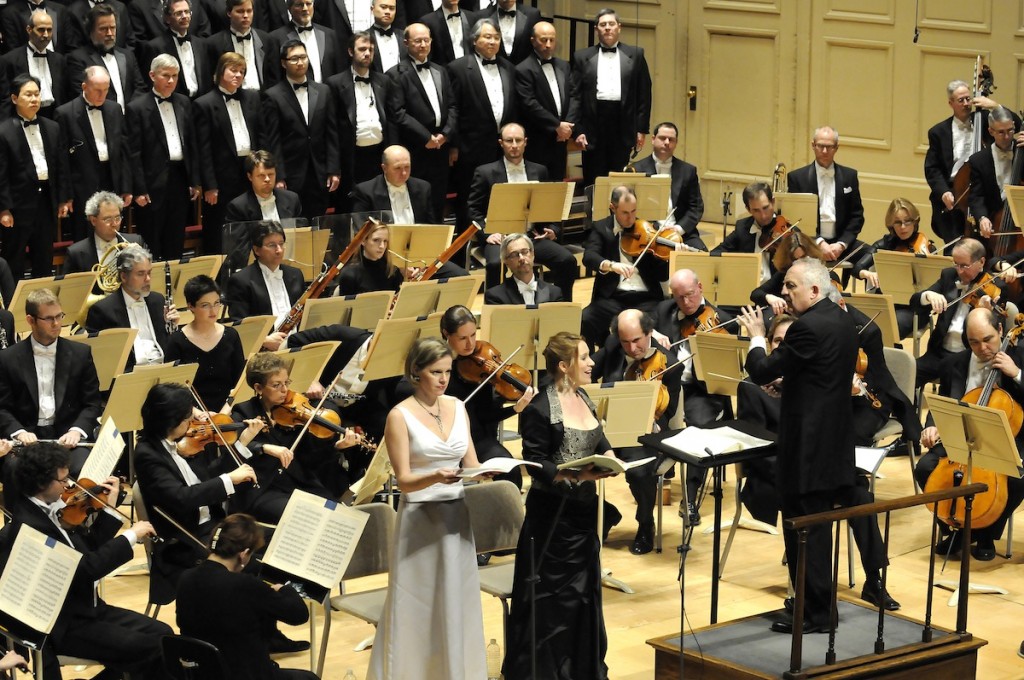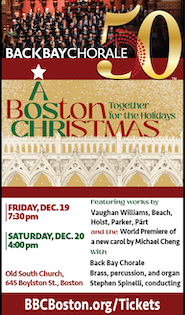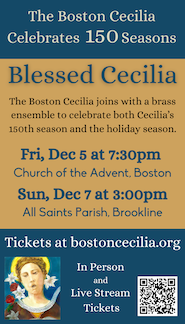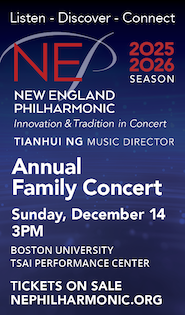BSO, soloists, and conductor excel in problematic Mendelssohn work

Bramwell Tovey conducts the Boston Symphony Orchestra, with soloists Camilla Tilling and Carolyn Sampson and the Tanglewood Festival Chorus Thursday night at Symphony Hall. Photo: Stu Rosner
If you don’t quite get Felix Mendelssohn’s Lobgesang for orchestra, soloists, and chorus — well, you had to be there.
You had to be in Leipzig in 1840, watching the young composer-conductor wrap up a music festival celebrating the 400th anniversary of Gutenberg’s invention of movable type with a big, happy new piece that everybody at the time agreed was terrific.
In Symphony Hall in 2012, as the sole work on a Thursday night subscription concert of the Boston Symphony Orchestra, Mendelssohn’s hearty, intermittently inspired festival-closer sounded as out of place as a rugby team in a ballet studio. Even a beautifully polished and committed performance by the orchestra, the Tanglewood Festival Chorus, and three capable vocal soloists under the direction of Bramwell Tovey (substituting for the indisposed Riccardo Chailly) couldn’t quite make the case for this musical miscellany as a coherent symphonic work.
Lobgesang (Hymn of Praise) consists of three brief orchestral movements welded to an oratorio-like sequence of nine choral or solo numbers. Stumped for what to call it, the composer finally settled on “symphony-cantata.” Most catalogues of Mendelssohn’s works now list it as his Symphony No. 2.
Bad idea. The last notes of the work’s Leipzig premiere had barely died away when another chorus began—that of musical analysts making invidious comparisons to a certain other symphony for orchestra and chorus. This cheerful piece shows no sign of striving to top Beethoven, but that hasn’t prevented generations of analysts from savaging it as, in the words of one, “the most dismal attempt to follow the lead of Beethoven’s Ninth Symphony ever conceived by human mediocrity.”
Whoa, take it easy! To begin with, Handel and Haydn have much more to do with Lobgesang than Beethoven does. By composing with formal Baroque dotted rhythms, fugue-like passages, and big Handelian blocks of choral sound, Mendelssohn was celebrating in musical terms the flowering of German culture, made possible in part by Gutenberg’s invention.
In that spirit, the Meistersinger-like glow of the work’s opening pages seems to promise musical riches ahead. The orchestra under Tovey sounded well knit, and well versed in that particularly graceful turn of phrase that is Mendelssohn’s hallmark. Beautifully shaped wind solos sprouted here and there, and the strings played especially vividly–incisive, agile, and sonorous by turns.
Though collectively titled “Sinfonia,” the three orchestral movements take their cue not from Baroque models but from 19th-century symphonies: a frisky sonata-form Allegro, a melancholy dance scherzo à la Dvořák that oddly alternates with a pious chorale melody, and an Adagio that sounds more amoroso than the marked religioso. These symphonic-style fragments give no inkling that an oratorio is on its way.
But then it arrives, and the chorus is featured in six of the nine movements. The Tanglewood Festival Chorus sang with its usual precision, but its sound sometimes went uncharacteristically hard and blatant, as if it were trying to kick some life into Mendelssohn’s chronically short, square phrases.
The soloists faced no such difficulties in their melodious parts (a world away from the taxing solos of Beethoven’s Ninth). Soprano Carolyn Sampson’s silvery, flexible voice floated over the orchestra with power in reserve. She was joined by soprano Camilla Tilling—not billed as a mezzo-soprano, but distinctly darker-toned than Sampson—in the blissful duet Ich harrete des Herrn, and one could understand why Robert Schumann called this music “a glimpse of heaven filled with Raphael’s madonnas.”
A “hymn of praise” is understandably short on dramatic tension, but Mendelssohn tries to generate some at the turning point of his darkness-to-light scenario, constructed from biblical texts. In the solo Stricke des Todes hatten uns umfangen, the tenor repeatedly asks, “Watchman, will the night soon pass?” amid a swirl of unresolved harmonies, until the soprano answers “The night has gone away!” in a sunburst of D major. (Comparisons to the “Chaos” movement of Haydn’s Creation are unavoidable here.) Tenor John Tessier fulfilled this assignment, and all others, in a somewhat reedy voice that made up in expressive diction for what it lacked in size.
While Bramwell Tovey deserves praise himself for stepping in and managing a well-crafted performance of this problematic piece, one can’t help wondering what insights may have prompted Riccardo Chailly to program it for what were to have been his debut appearance on the Boston podium. It’s another tantalizing question in a BSO season that has been full of what ifs.
The program will be repeated 7 p.m. Friday, 8 p.m. Saturday and Tuesday. bso.org; 617-266-1492.
Posted in Performances


